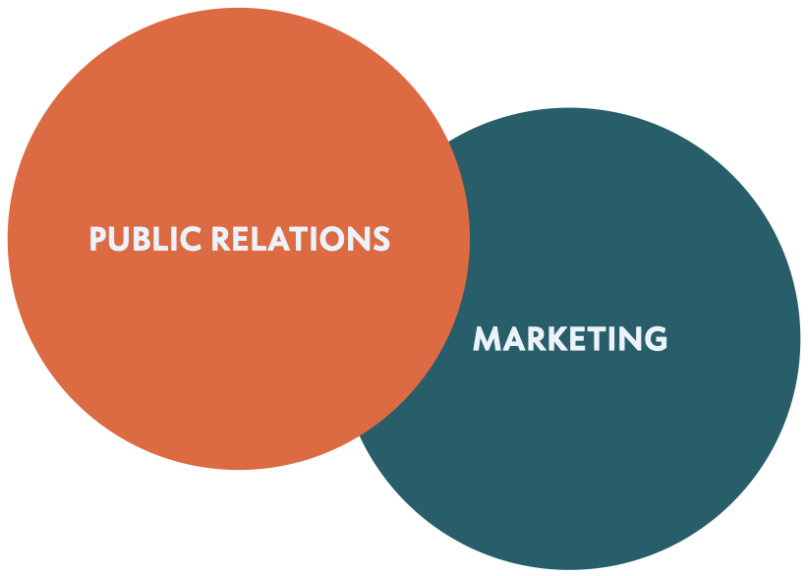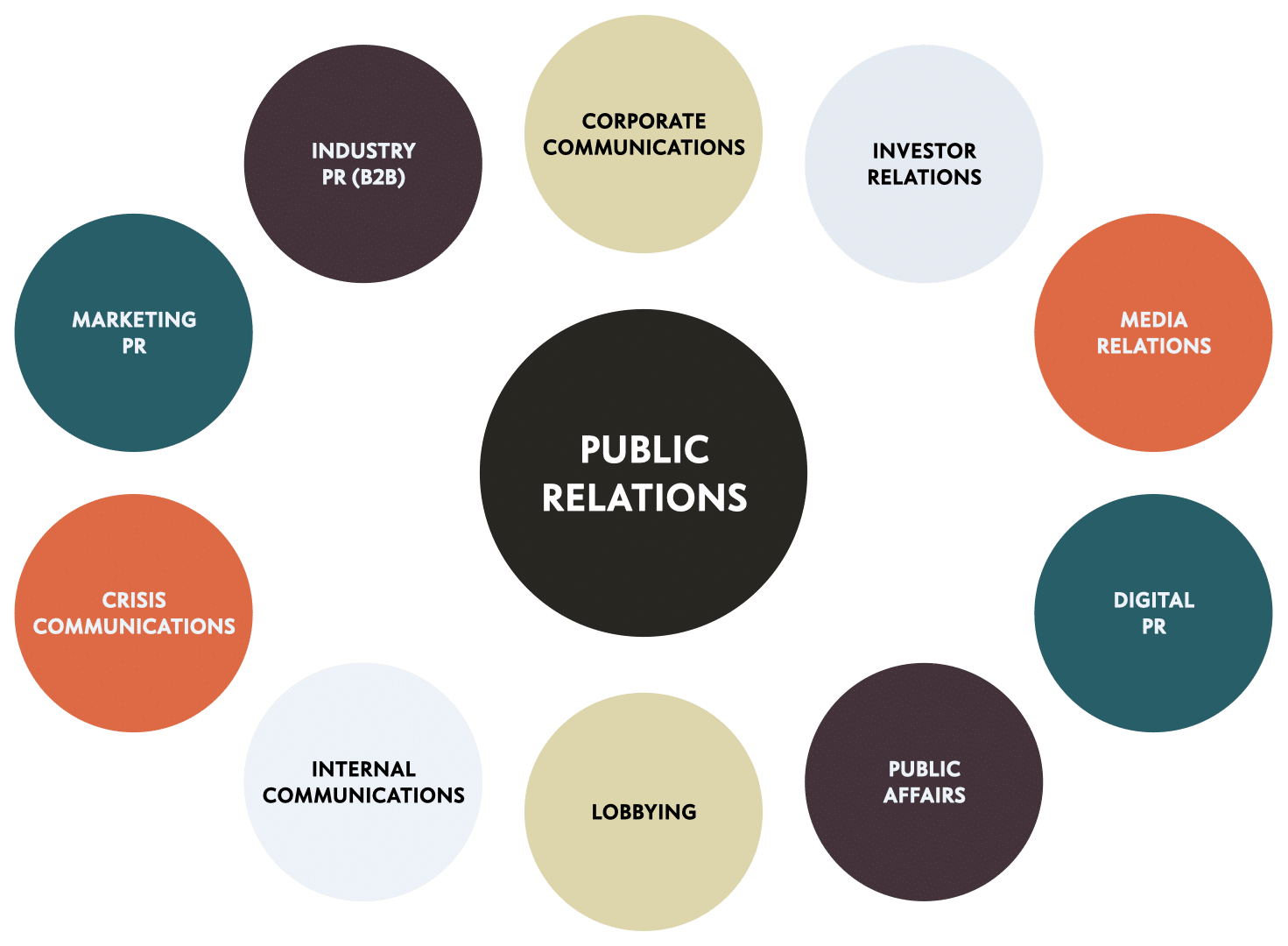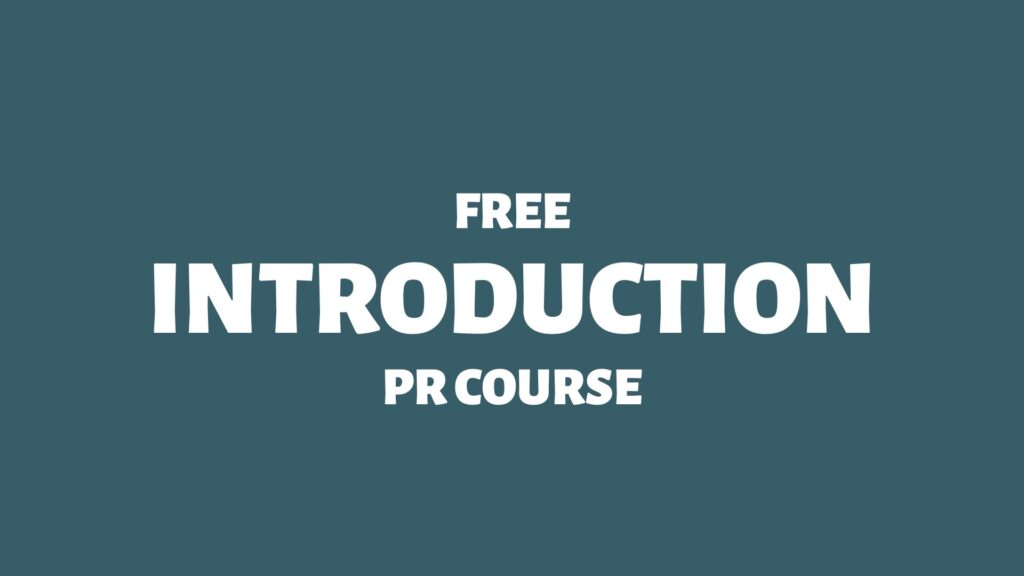Public relations vs marketing — what are the differences?
Public relations (PR) and marketing are closely related, but few know the differences.
In this blog post, let’s examine public relations and marketing differences.
Here we go:
Public Relations vs Marketing

Spin Academy | Online PR Courses
Public Relations vs Marketing
Public relations (PR) and marketing are essential components of an organisation’s strategy to promote and sell its products or services, but they focus on different areas and have distinct goals.
Here’s a breakdown of the main differences:
Objective
Audience
Tools and Tactics
Measurement of Success
Communication
Despite these differences, public relations and marketing often overlap and complement each other. 1For instance, a positive brand image built through effective PR can enhance marketing efforts, while successful marketing campaigns can contribute to a positive public image.
“Organizations benefit from the diversity of perspectives provided by separate public relations and marketing functions, with integrated marketing communication being a key strategy for organizational effectiveness.”
Source: Journal of Marketing Communications 2Grunig, J., & Grunig, L. (1998). The relationship between public relations and marketing in excellent organizations: evidence from the IABC study. Journal of Marketing Communications, 4, 141 – 162. … Continue reading
Larger organisations typically have a Marketing Department and a Communications/PR Department. Smaller organisations geared towards business-to-consumer markets typically place both functions within a Marketing Department. Smaller NGOs, non-profits, institutions, and business-to-business brands typically place both functions within a Communications/PR Department.
In most universities, Marketing is taught as a part of Business Administration. Public Relations is typically taught under Communications.
Learn more: Public Relations vs Marketing
💡 Subscribe and get a free ebook on how to get better PR ideas.

When PR is Better Than Marketing

Spin Academy | Online PR Courses
What Public Relations Does
“Public relations and marketing both use relationship-building techniques, but their missions and philosophies are fundamentally different.”
Source: Public Relations Review 3Broom, G., Lauzen, M., & Tucker, K. (1991). Public relations and marketing: Dividing the conceptual domain and operational turf. Public Relations Review, 17, 219 – 225. … Continue reading
Suppose you’re running a business and wish to be top-of-mind and sell more products and services. The go-to option is to double down on marketing to run ad campaigns, invest in SEM, or get into paid collaborations with influencers.
To get started, you develop a creative concept and a marketing strategy, which you pair up with copywriting and art direction to create your assets. After careful planning, you place your media budget with third-party publishers who can expose your messaging to potential customers.
That’s marketing!
However, there are lots of instances where the marketing toolbox falls short:
Media Relations
(Sometimes referred to as “Press Office.”)
“Organizations’ media relations activities can influence media content and opinions, but success depends on more than just distributing news releases.”
Source: Public Relations Review 4Turk, J. (1985). Information subsidies and influence. Public Relations Review, 11, 10 – 25. https://doi.org/10.1016/S0363-8111(85)80078 – 3
Some third-party publishers don’t accept payment because their livelihood depends on objectivity. Journalists (and influencers with journalistic ambitions) fall into this category. Their unbiased approach makes them highly influential.
Obviously, you cannot send your marketing assets to a journalist. They will refer you to their marketing department and ask you to pay for an ad!
However, a PR professional understands how to create material that a journalist (or an ambitious influencer) will want to feature to their audience.
Learn more: Media Relations
Corporate Communications
(Sometimes used interchangeably with “Communications” and “Inhouse PR” as a general term.)
“Corporate communication is a new [editor’s note: published in 1996] and growing discipline that focuses on communication within organizations, relating to management, business, and organizational aspects.”
Source: Management Communication Quarterly 5Argenti, P. (1996). Corporate Communication as a Discipline. Management Communication Quarterly, 10, 73 — 97. https://doi.org/10.1177/0893318996010001005
What if an organisation depends not just on whether people buy its products or services but also on what people think of your organisation and how it conducts its business? What if people want to discuss critical topics with the organisation?
Unfortunately, promoting your products and services to these people won’t cut it. However, public relations has professional know-how in this area.
Learn more: Corporate Communications
Investor Relations (IR)
“Investor relations officers significantly influence corporate disclosures and play a crucial role in private communication between IROs, analysts, and investors.”
Source: Journal of Accounting and Economics 6Brown, L., Call, A., Clement, M., & Sharp, N. (2019). Managing the narrative: Investor relations officers and corporate disclosure✰. Journal of Accounting and Economics. … Continue reading
In some organisations, especially large ones, there are various financial stakeholders. Shareholders, investors, financial institutions, etc. You cannot “do marketing” towards these groups; their informational needs differ from those of potential consumers.
But within public relations, we understand how to engage in two-way communication.
Learn more: Investor Relations (IR)
Digital PR
(Sometimes referred to as “Digital Communications,” “Online PR,” or “Online Communications.”)
“Online public relations can enhance visibility and build relationships with the public, promoting organizations and products through dialogic communication.”
Source: Procedia — Social and Behavioral Sciences 7Petrovici, M. (2014). E‑Public Relations: Impact and Efficiency. A Case Study. Procedia — Social and Behavioral Sciences, 141, 79 – 84. https://doi.org/10.1016/J.SBSPRO.2014.05.015
Not all online traffic is paid for by ads. People search organically for information, knowledge, inspiration, entertainment, etc. Some people even wish to be more than just customers — they want to be fans, followers, and subscribers!
And yes, public relations is equipped to cater to the informational needs of financial stakeholders.
Learn more: Digital PR
Public Affairs (PA)
“Integrating corporate planning and public affairs perspectives is crucial for organizations to effectively respond to environmental change and adapt to social and political turbulence.”
Source: Long Range Planning 8Post, J., Murray, E., Dickie, R., & Mahon, J. (1982). The public affairs function in American corporations: Development and relations with corporate planning. Long Range Planning, 15, 12 – 21. … Continue reading
For some organisations, it matters what the general public thinks about certain issues. For an electric car manufacturer, it matters what people think of the electrification of society. Because in a democracy, public opinion will ultimately shape public policy.
In public relations, we have the skill set to navigate and manage public perceptions and shape opinions long-term. While advertising can support such endeavours, the driving force is usually public relations.
Learn more: Public Affairs (PA)
Lobbying
“Lobbying can be viewed as a form of legislative subsidy, providing policy information, political intelligence, and legislative labor to strategically selected legislators, assisting natural allies in achieving their objectives.”
Source: American Political Science Review 9Hall, R., & Deardorff, A. (2006). Lobbying as Legislative Subsidy. American Political Science Review, 100, 69 — 84. https://doi.org/10.1017/S0003055406062010
At times, it’s a good idea to present your organisation’s ideas directly to those in charge of making the decisions, like politicians, legislators, analysts, topic experts, etc. And these groups are rarely convinced by marketing messages.
Learn more: Lobbying
Internal Communications (IC)
“Strengthening internal communication through various methods, including face-to-face communication, can improve employee engagement and build trust between management and employees.”
Source: International Journal of Business Communication 10Mishra, K., Boynton, L., & Mishra, A. (2014). Driving Employee Engagement. International Journal of Business Communication, 51, 183 — 202. https://doi.org/10.1177/2329488414525399
Most organisations have employees. Their opinions and attitudes towards the employer often decide whether the organisation will rise or fall. Aiming marketing campaigns at them rarely resolves any issues.
In public relations, we have a long and proud tradition of improving all types of communication within an organisation. (It’s also a major field of academic research!)
Learn more: Internal Communications (IC)
Crisis Communications
(Sometimes referred to as “Crisis Management.”)
“Effective crisis communication strategies, timing, and situational factors can guide managers in achieving desired outcomes and enhancing corporate reputation during crises.”
Source: Business Horizons 11Coombs, W. (2015). The value of communication during a crisis: Insights from strategic communication research. Business Horizons, 58, 141 – 148. https://doi.org/10.1016/J.BUSHOR.2014.10.003
Sometimes, things go wrong. In such situations, pausing all marketing campaigns is often a good idea. No one wants to see an ad for your business when people suffer or have gotten hurt.
We have developed a tried-and-tested toolbox in public relations to assist organisations in dealing with extremely challenging scenarios.
Learn more: Crisis Communications
Marketing PR
(Sometimes referred to as “Marketing Communications.”)
“Integrating marketing communications across traditional and new media can improve the effectiveness and efficiency of marketing programs.”
Source: Journal of Marketing 12Batra, R., & Keller, K. (2016). Integrating Marketing Communications: New Findings, New Lessons, and New Ideas. Journal of Marketing, 80, 122 — 145. https://doi.org/10.1509/jm.15.0419
Journalists and influencers are sometimes interested in consumer offerings, too. Not only are potential customers interested in learning about new products or services — journalists might be curious, too. This often happens when there are big launches or significant technological advancements.
This is where marketing and public relations “cross swords.” While marketing will use paid campaigns to push products or services, public relations will pitch those products or services to journalists (and influencers with journalistic ambitions).
Learn more: Marketing PR
Industry PR (B2B)
(Sometimes referred to as “B2B PR,” “B2B Communications,” or with more specificity, like “Tech PR,” “Telecom PR”, “Medical PR,” etc.)
“Contemporary public relations for B2B involves 7 distinct types of framing: situations, attributes, choices, actions, issues, responsibility, and news.”
Source: Journal of Public Relations Research 13Hallahan, K. (1999). Seven Models of Framing: Implications for Public Relations. Journal of Public Relations Research, 11, 205 – 242. https://doi.org/10.1207/S1532754XJPRR1103_02
In many industries, organisations sell products and services to other companies. Marketing can be important, especially if there are thousands of potential customers. However, many niches are small and dependent on personal relationships.
Also, many organisations depend on functional relationships with vendors, distributors, partners, suppliers, etc. Public relations is the way to communicate with these organisations.
Learn more: Industry PR (B2B)
All of the above types of public relations can be found in the stakeholder model.
As you can see, a lot of communication has to occur for most organisations — besides marketing. Marketing is a great tool, but public relations is sometimes the only way.
And, finally:
Why do most people know what marketing does — when the same thing cannot be said for public relations?
Marketing is big money. Marketing generates sales directly, which makes it a priority for many organisations. While media placements are expensive and require budgets exponentially larger than any budgets spent on communications, advertising exposure is also guaranteed.
“Public relations budgets and resources are often less well-defined and less accepted than marketing budgets and resources, but both disciplines contribute to the bottom line.”
Source: Public Relations for Marketing Professionals 14Haywood, R. (1998). Public relations budget and resources. Public Relations for Marketing Professionals, 83 – 96. https://doi.org/10.1007/978 – 1‑349 – 14365-8_5
Learn more: What Public Relations Does
💡 Subscribe and get a free ebook on how to get better PR ideas.


Thanks for reading. Please support my blog by sharing articles with other communications and marketing professionals. You might also consider my PR services or speaking engagements.
PR Resource: Public Relations 101

Spin Academy | Online PR Courses
Doctor Spin’s PR School: Free Introduction PR Course
Get started with this free Introduction PR Course and learn essential public relations skills and concepts for future success in the PR industry.
Introducing Public Relations
Comparing Public Relations
Reading List: PR Blogs
Learn more: All Free PR Courses
💡 Subscribe and get a free ebook on how to get better PR ideas.

ANNOTATIONS
| 1 | For instance, a positive brand image built through effective PR can enhance marketing efforts, while successful marketing campaigns can contribute to a positive public image. |
|---|---|
| 2 | Grunig, J., & Grunig, L. (1998). The relationship between public relations and marketing in excellent organizations: evidence from the IABC study. Journal of Marketing Communications, 4, 141 – 162. https://doi.org/10.1080/135272698345816 |
| 3 | Broom, G., Lauzen, M., & Tucker, K. (1991). Public relations and marketing: Dividing the conceptual domain and operational turf. Public Relations Review, 17, 219 – 225. https://doi.org/10.1016/0363 – 8111(91)90018‑G |
| 4 | Turk, J. (1985). Information subsidies and influence. Public Relations Review, 11, 10 – 25. https://doi.org/10.1016/S0363-8111(85)80078 – 3 |
| 5 | Argenti, P. (1996). Corporate Communication as a Discipline. Management Communication Quarterly, 10, 73 — 97. https://doi.org/10.1177/0893318996010001005 |
| 6 | Brown, L., Call, A., Clement, M., & Sharp, N. (2019). Managing the narrative: Investor relations officers and corporate disclosure✰. Journal of Accounting and Economics. https://doi.org/10.1016/J.JACCECO.2018.08.014 |
| 7 | Petrovici, M. (2014). E‑Public Relations: Impact and Efficiency. A Case Study. Procedia — Social and Behavioral Sciences, 141, 79 – 84. https://doi.org/10.1016/J.SBSPRO.2014.05.015 |
| 8 | Post, J., Murray, E., Dickie, R., & Mahon, J. (1982). The public affairs function in American corporations: Development and relations with corporate planning. Long Range Planning, 15, 12 – 21. https://doi.org/10.1016/0024 – 6301(82)90115 – 7 |
| 9 | Hall, R., & Deardorff, A. (2006). Lobbying as Legislative Subsidy. American Political Science Review, 100, 69 — 84. https://doi.org/10.1017/S0003055406062010 |
| 10 | Mishra, K., Boynton, L., & Mishra, A. (2014). Driving Employee Engagement. International Journal of Business Communication, 51, 183 — 202. https://doi.org/10.1177/2329488414525399 |
| 11 | Coombs, W. (2015). The value of communication during a crisis: Insights from strategic communication research. Business Horizons, 58, 141 – 148. https://doi.org/10.1016/J.BUSHOR.2014.10.003 |
| 12 | Batra, R., & Keller, K. (2016). Integrating Marketing Communications: New Findings, New Lessons, and New Ideas. Journal of Marketing, 80, 122 — 145. https://doi.org/10.1509/jm.15.0419 |
| 13 | Hallahan, K. (1999). Seven Models of Framing: Implications for Public Relations. Journal of Public Relations Research, 11, 205 – 242. https://doi.org/10.1207/S1532754XJPRR1103_02 |
| 14 | Haywood, R. (1998). Public relations budget and resources. Public Relations for Marketing Professionals, 83 – 96. https://doi.org/10.1007/978 – 1‑349 – 14365-8_5 |



